Moto G 3 vs Moto G 2: Should you upgrade?
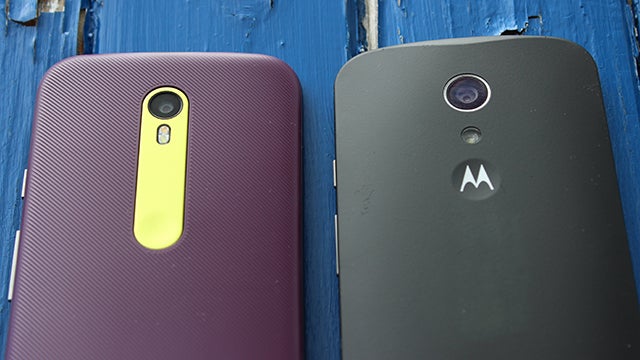
Moto G 3 or Moto G 2? We’ve spent a a fair amount of time with both of Motorola’s budget Android phones examining the differences to tell you whether it’s worth upgrading
We’ve finished our review of the Moto G 3 (2015) and our verdict is that this is another great Android phone instalment from Motorola.
We did also say the same about the Moto G 2 last year and with this year’s model retaining many of the features from its predecessor, on paper it looks like a tough decision to choose between the two.
Watch our Moto G (2015) hands-on video
Then there’s the change in pricing (more on that later) to consider as well.
Over the last couple of weeks, we’ve been living with the Moto G 2 and both the 8GB and 16GB versions of the Moto G 3 to help you decide which of these great phones you should go for.
Moto G 3 vs Moto G 2 – Design
Moto G 3 – Plastic water resistant body with customisable back shell and camera accent, 155g, 11.6mm thick
Moto G 2 – Plastic body, removable soft touch plastic back, 149g, 11m thick
At first glance, it doesn’t look like Motorola has dramatically overhauled the Moto G’s design at least from the front, but there’s both subtle and more radical changes to spot here. It’s the same glossy piano black screen bezel and gently curved corners with a plastic trim. The newer Moto G is heavier and thicker but not in a way that alters how it feels to use.
It’s still a manageable 5-inch phone that doesn’t have the cheap and nasty build quality we sometimes associate with phones in this price bracket.
Motorola has dropped the dual front-facing speakers for just one below the screen and you can now spot the more prominent 5-megapixel camera sensor tucked up in the corner. We do have to pick issue with the way the speaker and earpiece above and below the screen has changed. They’re more liable to trap more dust and muck than last year’s setup.
It’s around the back where things have really changed though. Now there’s a more grippy, textured plastic back as opposed to the soft touch plastic finish on the Moto G 2. We were fans of last year’s approach and while it now adopts a more plasticky look, it still feels nice and reassuring to grip.
You can still remove the back on both and it’s here where you’ll find the Micro SIM and micro SD card slots hidden away. Last year, Motorola offered a dual SIM card option although there’s no sign of a similar model for this year.
Related: Best Phone Deals: Top Smartphone offers this month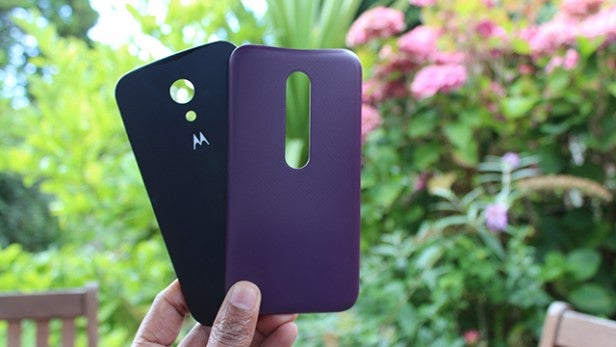
For the first time Motorola has also added its Moto Maker customisation tool, so you can change the colour of the back and the new metal accent that sits around the improved camera and dual-tone flash. We had a look at the purple and white models, and while we’re not the biggest fans of making things more colourful, it will no doubt appeal to some.
The biggest change here is that the new Moto G is now water resistant. Motorola has slapped it with an IPX7 certification so you can submerge it in water up to one metre depth for thirty minutes. We’ve taken it into the shower and left it in a sink of water and it passes the test. You won’t be able to do much with the screen when it’s running under water, but it does work and could save you from a potential watery disaster.
So which is the best looking of the two Motorola phones? We’d be inclined to say that visually, both are still attractive phones for the price and it really depends on how much you value a waterproof design and the extra customization. The new Moto G probably edges it, but not by much.
Related: iPhone 6 vs Samsung Galaxy S6 in-depth comparison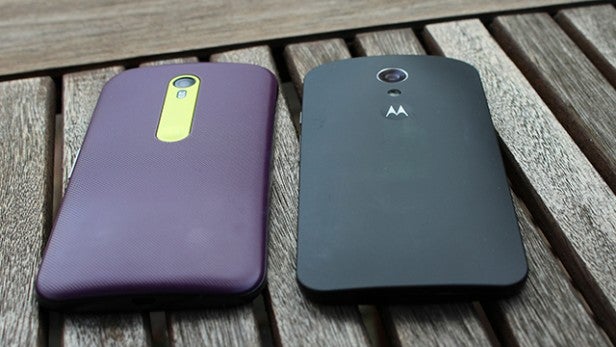
Moto G 3 vs Moto G 2 – Screen
Moto G 3 – 5-inch 720p HD LCD screen with 294 ppi pixel density and Gorilla Glass 3
Moto G 2 – 5-inch 720p HD LCD screen with 294 ppi pixel density and Gorillas Glass 3
Again it’s a game of spot the difference when you compare the two screens. Both 5-inch displays are based on the same LCD technology offering the same pixel density and layer of Gorilla Glass 3 to add protection against everyday bumps and knocks.
The most notable change is that Motorola has cranked the brightness up making it a little easier to see in bright sunlight. Other than that you get the same sharp, colourful surroundings for watching video and browsing.
Like last year’s model, app icons don’t look as high res as the UI, and whites are not exceptionally white on web pages. But on the whole, this is still a solid 720p HD screen. We just hope that it gets an upgrade to Full HD 1080p next year, because the likes of the Vodafone Smart Ultra 6 proves that it can be done.
Related: Moto G 2 (2014) vs Moto G (2013)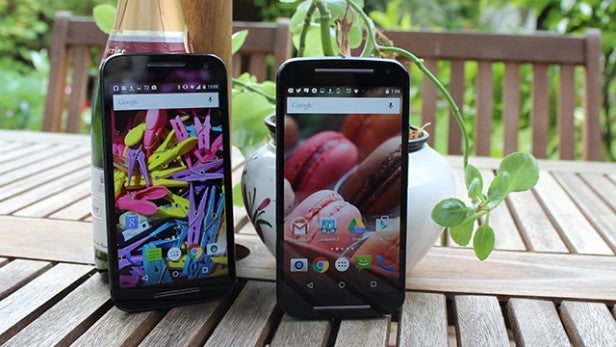
Moto G 3 vs Moto G 2 – Software
Moto G 3 – Android 5.1.1 with Motorola UI overlay
Moto G 2 – Android 5.0.2 with Motorola UI overlay
If you’re a fan of stock Android then you’re in luck with either Moto G. What we mean by stock is Google’s mobile operating system running in its purest form, without any tinkering from the hardware manufacturers. While it’s not 100% pure Android here, it’s as close as you can get and Motorola’s presence is kept to the bare minimum.
That means of all the new Android Lollipop features are present like the new Material Design and more actionable notifications. In the case of the Moto G (2015), you also get some Moto X-inspired features like the ability to shake the phone to turn the camera on or the standby notification mode, where you can glance at incoming messages from apps like Hangouts without fully turning on the screen.
For apps, both are fully packed with Google’s finest including Chrome, Drive and native applications like the Calendar app. While last year’s Moto G had separate apps for Motorola’s Assist, Alert and Connect and Migrate apps, things have been stripped back this year. Now there’s just a Migrate app and a Moto app where you can still get access to the Assist mode to set up profiles for activities and parts of the day when you don’t want to be interrupted.
On the whole, both offer clean, easy to use operating systems that are not bogged down by needless bloatware and that can only be a good thing.
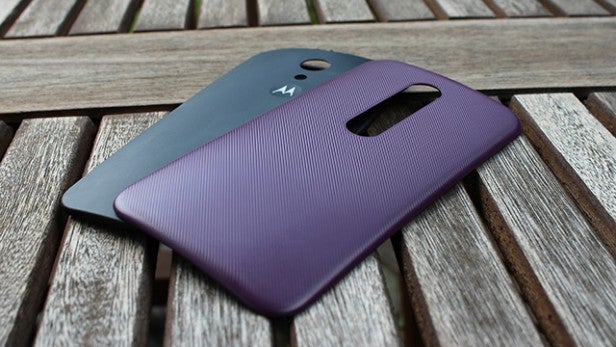
Moto G 3 vs Moto G 2 – Performance and Storage
Moto G 3 – 1.4 GHz Snapdragon 410 quad-core processor, Adreno 306 GPU, 1GB RAM (8GB) or 2GB RAM (16GB)
Moto G 2 – 1.2 GHz Snapdragon 400 quad-core processor, Adreno 305 GPU, 1GB RAM (8GB)
It’s no surprise to see that Motorola has upgraded the Moto G’s internals bringing it in line with other Android phones we’ve seen launch in this price range in 2015. The 410 processor is the natural successor to the 400 and with a decent GPU and slick Android OS, there’s plenty of zip to overall performance. The same can be similarly said about the Moto G 2, but we have found that over time, some sluggishness has crept in.
Where things do get interesting is on the RAM front. While last year’s model only has the 1GB of RAM to help with multitasking, the new Moto G has the option for an extra GB of RAM to better cater for those power users. It shows in the performance as you’ll see from the benchmarks we ran for our review. The problem here is that to get that extra RAM you need to buy the 16GB Moto G and that pushes the price of the handset over £200. It does make a difference, but is it worth the extra cost? That entirely depends on how intensively you plan to use it.
From a storage point of view, whether you go for 8GB or 16GB, you won’t be getting the full compliment of that space. But you do have that micro SD card slot lurking in the back so you can invest in a micro SD card and have more room for your content.
On the connectivity front, there’s now 4G from that start with the Moto G (2015) model so you won’t have to wait around for an upgraded model to come out later on.
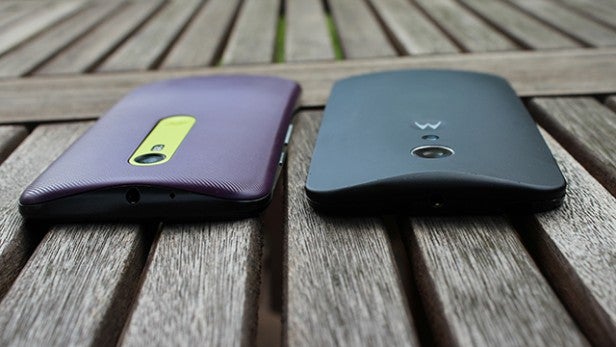
Moto G 3 vs Moto G 2 – Camera
Moto G 3 – 13-megapixel main camera with dual-tone LED flash, 5-megapixel front-facing camera, 1080p HD video recording at 30fps
Moto G 2 – 8-megapixel main camera with LED flash, 2-megapixel front-facing camera, 720p HD video recording at 30fps
With the first Moto G, the camera was arguably its weakest feature. Motorola made big improvements with this on the Moto G 2 and it’s more of the same with the Moto G this year.
You’ll notice that the megapixel count has risen significantly in comparison, but you also get an improved flash setup and a sizeable f2.0 lens. It’s the kind of camera specs we’d associate with more expensive smartphones and is basically the one you can find on the Nexus 6.
Motorola has also upped the front-facing camera to a 5-megapixel sensor, which is a step up in image quality on its predecessor with the added bonus of a HDR mode to brighten those selfies up. You won’t get groundbreaking results but it’s a noticeable improvement on the Moto G 2.
When it comes to shooting with the main camera, you can really notice the difference between the two. There’s pretty much the same camera app to use, which means swiping in from the sides of the screen to view settings and get quick access to the gallery. It’s an easy to use app and doesn’t get in the way of taking those photos in a speedy fashion.
We’ve added a few samples below to show you what we mean. Generally with good light, images are sharper, brighter and produce more accurate colours on the new Moto G. Both sadly don’t do great when it comes to shooting at night, but that’s to be expected when it’s lacking features like optical image stabilization and you don’t have a larger lens to play with here.
Moto G 2 photo sample

Moto G 3 (2015) photo sample

Moto G 2 photo sample

Moto G 3 (2015) produces more composed, detailed images
This is where the two phones feels the most different. The Moto G last year had a good camera, but this time it’s so much better.
Related: Moto G 2 vs Moto E – What’s the difference?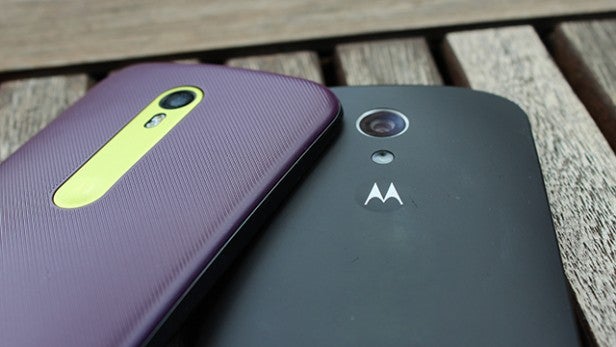
Moto G 3 vs Moto G 2 – Battery
Moto G 3 – 2470mAh non-removable battery with power saving mode
Moto G 2 – 2070mAh non-removable battery with power saving mode
When you compare the battery capacities of the first Moto G and the Moto G 2, surprisingly there wasn’t a massive difference despite the jump in screen size. This year, Motorola has added an extra 400mAh to help keep things running longer.
In our tests, we found that in general, both phones are capable of getting you through a day with enough to spare for another work day before you’re scrambling for a charger at around 6-7pm. Last year’s Moto G relies more heavily on the power saving mode to make that happen. You can find that in the settings menu and it’ll restrict data from any apps running in the background.
With our more extreme tests running a 720p HD video on loop, you’ll get an hour more with the new Moto G. Both have similar battery drop-offs when you’re streaming for around an hour of video and they’re similarly not the quickest at restoring battery when you’re running low.
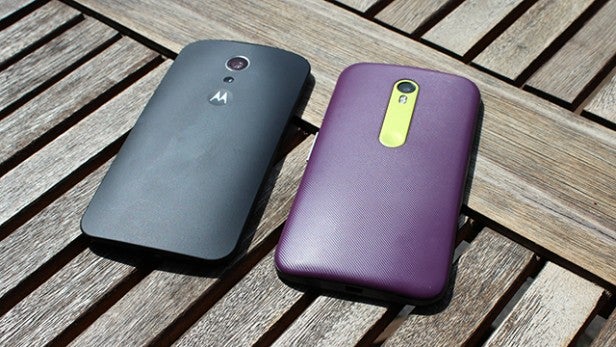
Moto G 3 vs Moto G 2 – Price
Moto G 3 – £179 from Motorola SIM-free, £159 from selected UK networks, £139 from Three PAYG
Moto G 2 – £144.99 at launch, SIM-free prices range start £120
We’ve already touched on this earlier about the change in pricing for the Moto G, but here’s better breakdown of this confusing mess.
Directly from Motorola it’s priced at £179 for the 8GB version and £209 if you want that storage upped to 16GB. It’s also important to note that the 16GB version doubles the RAM to 2GB. Another benefit of buying it directly is access to Moto Maker, this is included in the price, so you can customise the rear colour and accents.
Three has it on sale for £159.99, though it’s only selling the 8GB/1GB RAM version. But, it will give you a voucher to use of Moto Maker so you’ll still be able to personalise it. Considering all Three phones are sold unlocked, this is a good route to go down. You can also grab it for as cheap as £139.99 and that’s on Pay as You Go.
O2 simply has an all-black, 8GB model for sale costing £154.99. Cheaper, though less personal.
Carphone Warehouse prices the Moto G (2015) at £179.99, again for the 8GB model. There’s no Moto Maker, but an exclusive white and green colour combo if black is just too boring for you.
EE and Vodafone don’t seem to be stocking it yet, we’ll update this when they do, while Clove has it for £159.99 in black and white.
So that’s a lot of pricing information to take in. What is clear is that you can get the new Moto G for less if you shop around. If you’re willing to stick with last year’s model, things have got cheaper and places like Amazon are selling it for as cheap as £120, which still makes it a bargain.
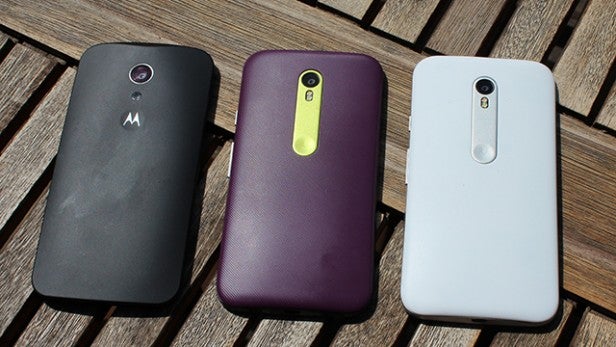
Verdict
So which Moto G is the best? We’d have to say that the new model makes the changes in all the right places. We like that it now has a waterproof design and does it without changing the look and feel of the phone. The camera is a massive step up on last year and if you go for the 16GB model, you get the benefit of that extra GB of RAM.
Where the phones don’t feel all that different is when you look at the screen, the battery and the operating system. It’s near enough identical experience on all those fronts. So if those are things you value in a phone, then you might be persuaded to stick with the Moto G 2.
We should of course talk pricing here. The Moto G (2015) is £30-40 more than last year depending on where you buy it from pushing it away from that more attractive sub-£150 price point. If you go for the 16GB model it’s even more. If you can live without a top notch camera and a waterproof design, the Moto G 2 is still a great option. If you want the best, go with the newest model and you won’t be disappointed that you did.
What do you think of the Moto G (2015)? Let us know in the comment box below


